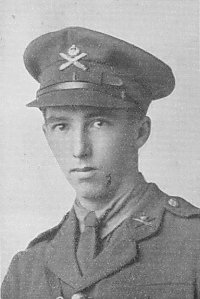
CHARLES LEONARD STOKES
The Stokes family were used to moving around the country following the head of the household, Charles William Stokes, as he persued his trade as a commercial traveller. Despite being born in Lincolnshire Charles William seems to have moved his family to Portsmouth on at least two extended occasions. On the first, according to the 1891 Census, the family lived at 28 Albert Grove, Southsea, then, after a period at Crouch End during which the 1901 Census was taken, at 32 Nelson Road, Southsea for the 1911 Census when Charles William described himself as a Tea Merchant. That he found himself at a good address in Southsea is perhaps surprising given that before he married and started a family he had, according to the 1871 Census been sent to the County Prison, Leicester. The reason for this is unknown.
Charles Leonard Stokes was born in 1896 to Charles William and his wife Elizabeth Jackson Stokes. He had a sister Daisy who was thirteen years older and three younger sisters, Doris, Georgina and Mabel. He attended the Secondary School at the north end of Victoria Road North from 1907 to 1912. 'He received the full school course and passed the Oxford Senior Local Examination in 1911. He joined in the social life of the school, and the successful part he played in school entertainments will be remembered by his schoolfellows of that period.'

'After leaving school he entered the service of the Northern Assurance Company at the Portsmouth Branch in September, 1912, as Junior Clerk. Prior to the outbreak of war he was in the Territorial Forces, and was called up as a Gunner in the Hampshire Royal Garrison Artillery on mobilisation, August 5th, 1914, and stationed at Southsea Castle. In April, 1915, he contracted measles and developed pneumonia and pleurisy, and in consequence was in hospital and at a convalescent home for over five months.
'Shortly after rejoining he was granted a commission and was gazetted on 26th October to the 2/6th Hampshire Regiment and, after training at Bournemouth, was transferred to the Machine Gun Corps at Grantham, where he completed his training, and was sent out to France on 16th June, 1916. He was wounded in action on 19th July and sent home to recuperate. He returned to France in April, 1917, and was in action at the capture of Bullecourt and several other important towns.
'He was promoted full Lieutenant on 18th June, 1917, and after ten days' leave in August rejoined his regiment, and was killed in action on 26th September, 1917. He was buried on the field of battle between "Inverness Cape" and "Stirling Castle" Wood.
'The Captain of the 19th Company Machine Gun Corps wrote of him :-" He was gallantly encouraging his men during the attack when a splinter struck him, killing him instantaneously. He was an extremely capable officer and very popular with officers and men." '
Further Information
The photograph above is taken from a memorial booklet published by Southern Grammar School from which extracts also appear above.
The Commonwealth War Graves Commission (CWGC) website lists Lieutenant Charles Leonard Stokes, Hampshire Regiment (6th Battalion attached to 19th Battalion. Machine Gun Corps (Infantry)), date of death, 26/09/1917, aged 21. He has no known grave and is remembered on the Tyne Cot Memorial.
Charles Stokes's name appears on the Southern Grammar School WW1 Memorial, the Cenotaph and the Royal Garrison Artillery Memorial at the Royal Garrison Church.
Tim Backhouse
December 2013